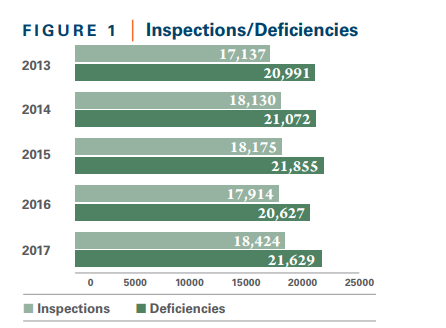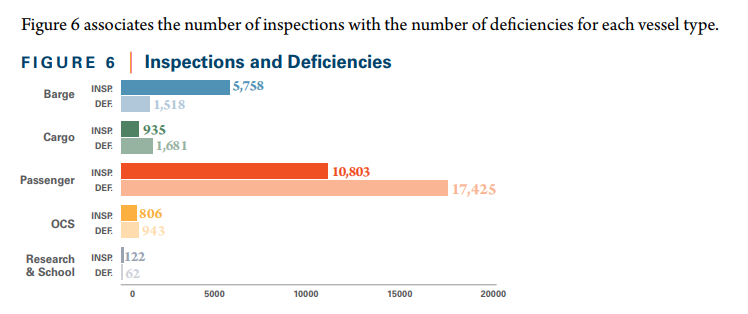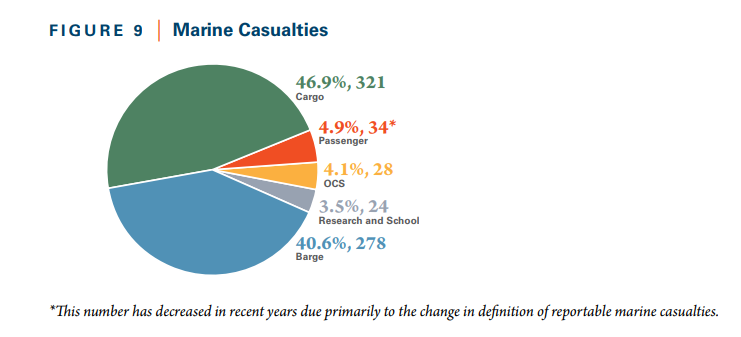The US Coast Guard issued its Domestic Vessel Annual Report, collating data from the USCG’s Marine Information Safety and Law Enforcement (MISLE) database regarding vessel population, inspections conducted, and deficiencies issued for the 2017 calendar year.

Highlights
- Of the 18,424 inspections conducted in 2017, 21,629 deficiencies were identified on the 12,189 active vessels in the US fleet of responsibility.
- Passenger vessels account for 81% of those deficiencies. However, based on the overall vessel population, cargo vessels received a higher ratio of deficiencies per vessel, with an average of 5.17.
- There were 685 reportable marine casualties reported in 2017, with the highest percentage involving cargo vessels, at 46.9%.

-Barges
- In 2017, the barge fleet consisted of 4,865 active vessels, which represented 40% of the overall U.S. domestic fleet.
- 5,758 inspections were conducted on barges in 2017, during which 1,518 deficiencies were identified at a ratio of 0.31 deficiencies per vessel.
- In comparison to the overall flag state fleet totals, barge inspections accounted for 31% of all inspections and 7% of all deficiencies.
- Of the 685 reportable marine casualties in 2017, 278 or 41% of these events involved a barge.
- The top reportable marine casualty events involving the barge fleet were: Allision 24.8%, Grounding 19.8%, Pollution 18.3%.
-Cargo
- In 2017, the cargo vessel fleet consisted of 325 active vessels, which represented 3% of the overall fleet size.
- The Coast Guard conducted 935 inspections in 2017, during which 1,681 deficiencies were identified at a ratio of 5.17 deficiencies per vessel.
- Cargo vessel inspections accounted for 5% of the total inspections and 8% of the overall Coast Guard issued deficiencies.
- Of the total number of 685 reportable marine casualties in 2017, 321 or 47% of these events involved a cargo vessel.
- The top three most prevalent types of reportable marine casualty events involving cargo vessels were: Material Failure/ Malfunction 49.5%, Loss/Reduction of Propulsion/Steering 26.2%, and Loss of Electrical Power 9.3%
-Passenger
- In 2017, the inspected passenger vessel fleet consisted of 6,353 active vessels, which represented 52% of the overall fleet.
- There were 10,803 passenger vessel inspections conducted in 2017, during which 17,425 deficiencies were identified at a ratio of 2.74 deficiencies per vessel.
- In comparison to the overall flag state fleet totals, passenger vessel inspections accounted for 59% of the inspections and 81% of the deficiencies.
- Of the 685 reportable marine casualties in 2017, 34 or 5% of these events involved an inspected passenger vessel.
- The top three reportable marine casualty events involving the inspected passenger vessel fleet, were Material Failure/ Malfunction 23.5%, Loss/Reduction of Propulsion/Steering 20.6%, and Flooding 11.8%

-OCS
- In 2017, the outer continental shelf (OCS) fleet consisted of 595 active vessels, which represented 5% of the overall fleet size.
- There were 806 OCS inspections conducted in 2017, during which 943 deficiencies were identified at a ratio of 1.58 deficiencies per vessel.
- In comparison to the overall flag state fleet totals, OCS inspections accounted for 4% of inspections and 4% of deficiencies.
- Of the 685 reportable marine casualties in 2017, 28 or 4% of these events involved a member of the OCS fleet.
- The top three reportable marine casualty events involving the OCS fleet, were Material Failure/ Malfunction 35.7%, Allision 17.9%, and Fire 10.7%
-Research and School
- In 2017, this fleet consisted of 51 active vessels, which represented 0.4% of the overall fleet size.
- There were 122 inspections conducted in 2017, during which 62 deficiencies were identified at a ratio of 1.22 deficiencies per vessel.
- In comparison to the overall flag state fleet totals, research and school ship inspections accounted for 0.7% of inspections and 0.3% of deficiencies.
- Of the total number of 685 reportable marine casualties in 2017, 24 or 3.5% of these events involved a research vessel or school ship.
- The top three reportable marine casualty events involving this fleet were Loss/Reduction of Propulsion/ Steering 29.2%, Material Failure/ Malfunction 16.7%, and Allision 16.7%
Explore more herebelow:































































